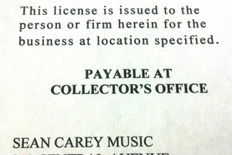 So okay. Many of you understand how private music lessons are conducted. You pay a qualified teacher to teach you or your child and in return you pay a weekly or monthly fee, sometimes called 'tuition' to the instructor or music school. But there are many folks who don't seem to understand why teachers set the rates they do. Recently, I wrote a short article in the Studio newsletter titled 'Where does all my tuition money go?' Here it is: "The tuition paid by students every month covers much more than just the thirty minute lesson. It also covers preparation time and expenses for instructional materials, printing costs, office supplies and Studio expenses, incentives for students, bookkeeping, trips to local music shops, your instructor’s training and professional development, professional organization memberships maintained by the instructor, taxes, newsletters, travel expenses and vehicle maintenance, business license fees, website design and fees, Studio promotional items and advertising. They say that time is money, and in the case of a music studio, it is really true. All these things make it possible to provide quality lessons for all students. Rates and fees are kept as low as possible to keep them affordable and competitive." There is a high price to operate a small music studio, and many teachers simply stop at the thirty minute lesson, effectively bypassing the higher costs associated with running an actual studio. You see, part of running a studio is running a business. Who pays the business fees and taxes? I do. Who pays for materials and printing and office supplies such as ink and paper? I do. Who pays for the internet connection and maintenance of digital devices? What about strings for guitars, picks and books and lesson materials? What about all the time it takes to personalize each lesson to each individual student? Advertising costs? That's right, just me. Did you I also pay for internet service provider fees, website hosting and email? Or how about the ever-rising gasoline prices I pay to fuel my vehicle in order to bring lessons to your home? How is it even possible to keep up with all of that? You might say, "Just get more students." That's very hard to do if you only offer a thirty minute lesson and do absolutely nothing to promote your service. For private music teachers, it is a constant struggle to keep a studio growing. When I restructured my payment policy in March, I abandoned the payment-by-week method and opted for a set monthly rate. That change means that now a student can expect 50 lessons per year and the cost increased only 60 cents per lesson. Sixty cents! That is not even enough to cover travel expenses per student. So far I have been able to keep my Studio tuition rates affordable, and comparatively my rates are on the low end. Incidentally, there are no plans for a tuition increase for the 2014 year at this time. So the next time you hear someone beleaguer the cost of private lessons, go ahead and remind them where all the money really goes. Music teachers everywhere will thank you. ♫ Sean
2 Comments
|
Studio BlogDiscussions on topics related to musicianship. Archives
January 2016
Categories
All
|
|
© 2012-2023 Sean Carey Music LLC.
All Rights Reserved. |

 RSS Feed
RSS Feed

